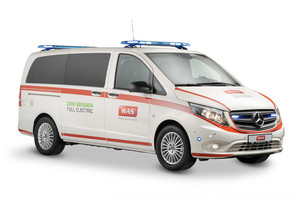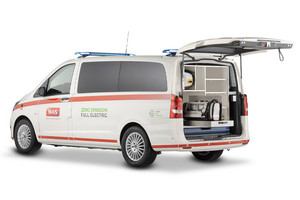In March of last year, the German Red Cross (DRK) in Frankfurt am Main had already tested the electric ambulance in the 5 t class from WAS in action (see Rettungsdienst 7/2022). In November 2022, the team tested the eVito (WAS 100-E NEF) from Mercedes, which WAS had converted into a first response vehicle. The special thing about it was that while the e-ambulance was a completely self-built WAS vehicle, the NEF was a series-produced electric vehicle from a renowned manufacturer. With the former, WAS determined the entire electrical supply of the drive as well as that of the medical equipment itself. In the case of the E-NEF, they had to adhere to the manufacturer‘s specifications and adapt the installation accordingly. “That was a bit of a challenge”, explains Christoph Stegemann, responsible for the e-vehicle division at WAS. The aim was not to exceed the total weight of 3.5 t during the mission, whilst remaining fully equipped and functional for the deployment of emergency doctors. After several previous tests, our WAS 100-E NEF was ready for our first 'real' test customer, the Frankfurt Red Cross. For eight days, it was available to the emergency team 24 hours a day to be put through its paces under real conditions.
Charging ifrastructure and training is a must.
It goes without saying that for the use of an e-vehicle, there must be at least one 'electric charging station' at the deployment site. The chosen emergency ambulance location was the St. Elisabethen Hospital in the Bockenheim district with an 11 kW charging capability. Since it was not possible to predict which other hospitals would have to be visited, it was not worthwhile to install further charging stations on spec specifically for the test period. The 370 km range according to WLTP of the eVito should also be enough! The handling of the vehicle, especially the driving behaviour, the drive and the recuperation function (electric brake and energy recovery for the batteries) with the five possible levels, should be learned before going into action. The task forces were trained accordingly.
Test result: user recommended.
All drivers and emergency personnel who took part in the 67 operations were interviewed, and their feedback was all positive. The vehicle never hit a critical range (less than 60 km); and the diesel-powered backup emergency vehicle provided for this case did not have to be deployed. According to the report, three out of four emergency paramedics deployed can imagine “...using a purely electric first response vehicle in the Frankfurt ambulance service.” However, also in this case, as in the e-ambulance test last year, it is true that in order to be able to make a relevant contribution to the energy transition in the ambulance service, the charging infrastructure must be significantly expanded. The two authors of the test report are Julian Heilmann and Katharina Huck, both emergency paramedics at the DRK district association in Frankfurt am Main. (Report: Rettungsdienst 2/2023).
Several other customers have already tested or are planning to test the WAS 100-E first responder. The feedback remains consistantly positive, mirroring the test described above.
The WAS 100-E NEF in detail:
High performance
The powerful 150 kW drive with a torque of 365 Nm enables a top speed of 160 km/h and impresses with high acceleration values.
Long range
With one battery charge, the range is around 370 km (WLTP) - and that‘s with a permissible gross weight of 3.5 tonnes.
Short charging times
Mit einer Ladezeit von nur 40 Minuten bei einer Ladeleistung von DC 110 kW ist der E-Notarzteinsatzfahrzeug flexibel einsetzbar, verlässlich und schnell wieder unterwegs. Die Ladezeiten können hervorragend zwischen den Einsätzen genutzt werden.
Short charging times
With a charging time of only 40 minutes at a charging power of DC 110 kW, the e-emergency response vehicle is flexible, reliable and is quickly back on the road. The charging times can be excellently used between assignments.
Sustainability is promoted
E-mobility is promoted by the BMVI (Federal Ministry of Transport and Digital Infrastructure) as a key technology for a future-oriented and sustainable transport system. Electromobility projects in the emergency services also benefit from this in terms of the procurement of electric vehicles and the expansion of charging infrastructure. In addition, there are many local funding pots. With such funding, the new e-fleet pays off even more.
Individual interior design
The modular interior design of the WAS 100 first response vehicle, which is typical for WAS, also makes individual interior fittings possible and affordable in the E-version, depending on the focus of the operation.
Low operating costs
The e-first responder saves money and time in two areas: Firstly, an electric drive is much more efficient than a dieselpowered vehicle. Secondly, there are no maintenance costs and times for oil changes and other maintenance measures that are necessary for the safe operation of a combustion engine. Fault-prone components such as turbochargers or gearboxes are also completely eliminated.
Excellent road handling
The good road handling of the conventional Vitos is further improved in the e-version because the heavy batteries are installed in the floor assembly. This also increases safety for all emergency services during all operations.










No Comments